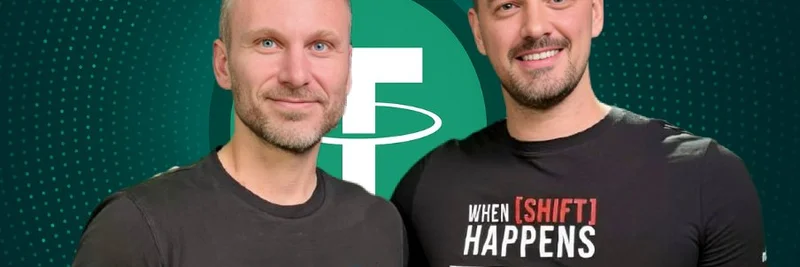In a recent episode of the "When Shift Happens" podcast, host Kevin from KevinWSHPod sat down with Paolo Ardoino, the CEO of Tether and CTO of Bitfinex. The discussion dives deep into why stablecoins like USDT are more than just digital dollars—they're tools for real-world change, especially in places where traditional banking falls short. If you're in the crypto space, whether trading meme tokens or building on blockchain, understanding stablecoins is key because they often serve as the backbone for liquidity and stability.
Tether's Massive Profits and What They Mean
Paolo doesn't shy away from the numbers: Tether raked in a whopping $13.7 billion in profits last year, with similar expectations for this year. That's impressive, especially when you break it down to about $100 million per employee. But here's the thing—it's not just about the cash. Higher interest rates since 2022 have helped, sure, but the real secret sauce is Tether's lean operation. With a small core team handling the massive scale of USDT, they're reinvesting most of those profits into tech, infrastructure, and bold long-term projects.
As Paolo puts it, "It's not about the money, it's about sending a message." That message? Tether's vision is way bigger than its current size. They're aiming for a "100-fold" growth in impact, focusing on stability in an unstable world.
Building a 'Stable Company' for Unstable Times
One of the standout ideas from the chat is Paolo's concept of Tether as a "stable company," not just a stablecoin issuer. Stablecoins are cryptocurrencies designed to maintain a steady value, usually pegged to something like the US dollar. USDT, for example, aims to always be worth $1.
In the West, where banking is pretty reliable (think 90% efficiency), stablecoins might seem like a nice-to-have. But in emerging markets, where financial systems can be as low as 5% reliable, jumping to 60-70% efficiency through stablecoins can transform lives. Paolo explains that money is the "ultimate social network"—it lets people exchange value peer-to-peer, building communities and reducing chaos from inequality.
This ties into broader blockchain goals. For meme token enthusiasts, stablecoins like USDT are often the on-ramp: you trade volatile memes against stable assets to lock in gains or hedge risks. Tether's mission aligns with making crypto accessible, which indirectly boosts the entire ecosystem, including fun, community-driven projects.
Profits as Fuel for Innovation
Paolo emphasizes that 95% of Tether's profits stay in the business or fund new ventures in areas like open telecoms, social infrastructure, and energy. He outlines a framework for lasting companies: a strong philosophy, innovation chops, and capital to execute. Tether has all three, which is rare in crypto.
Floating the idea of raising $20 billion at a $500 billion valuation isn't about hoarding wealth—it's about signaling ambition and drawing in partners for century-long goals. Again, quoting the Joker: "It's not about the money, it's about sending a message."
Paolo's Personal Drive and Early Roots
The conversation gets personal too. Growing up in Italy, Paolo learned the value of hard work from his family—grandparents tending farms for perfect produce, his dad scraping together money for an early computer. By age seven, Paolo was coding his own games when he ran out of pre-made ones.
That builder mindset carries through today. He still oversees Bitfinex, sleeping just five hours a night with hourly checks. It's tough, but for him, it's about responsibility in a 24/7 industry.
Simplifying Stablecoins for Everyone
If you're new to this, Paolo breaks it down simply: A stablecoin is like the digital cash in your bank account, but on a decentralized, global blockchain instead of a single bank's servers. It moves fast, settles programmatically, and opens doors for the unbanked or those in hyperinflating economies.
Data shows most USDT users stick to stablecoin transactions, not speculative trades—proof it's used as real money.
Efficiency, Expansion, and Avoiding Hype
Tether's per-employee profits stem from keeping the core business efficient while expanding smartly. Headcount was tiny until recently, now growing for AI and product devs. Paolo critiques crypto's hype cycles—like "dogs with hats" (a nod to meme coins)—and pushes for usable infrastructure, like lower fees and easier USDT movement without needing extra tokens like ETH.
Investments in projects like Plasma aim at mainstream adoption, prioritizing users in places like Africa over Wall Street elites.
The Surprising Juventus Investment
One curveball: Tether's 10% stake in Juventus Football Club. Paolo, a fan, sees it as a distribution play. With millions of global fans, modernizing fan engagement and monetization could be a model for reaching everyday people. It's about scaling crypto's benefits through beloved brands.
The Builder's Obsession
Throughout, Paolo's theme is obsession with building. No hobbies—just deep dives into coding, farming perfection, or ensuring Tether's uptime. He calls it a "once-in-a-century company" because it thrives on openness and decentralization, growing stronger as more people join the network.
If this sparks your interest in how stablecoins underpin the crypto world—including the wild ride of meme tokens—check out the full episode on YouTube or your favorite podcast app. For the original thread, head over to Kevin's post on X.



